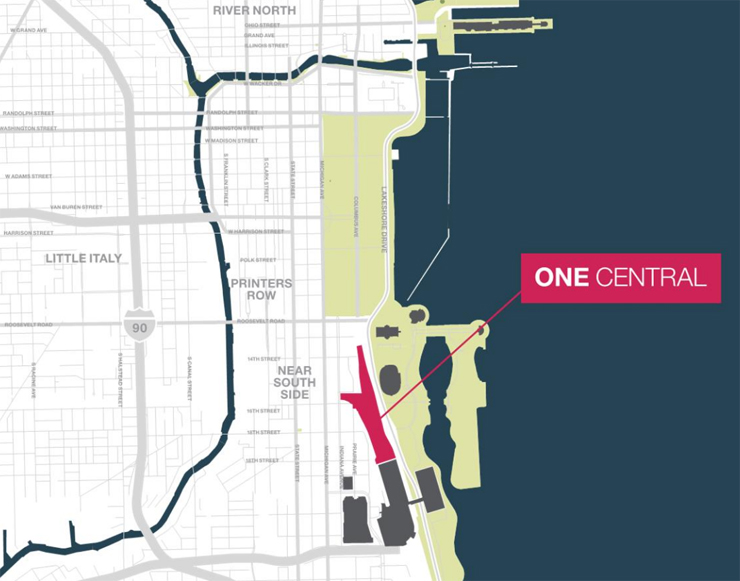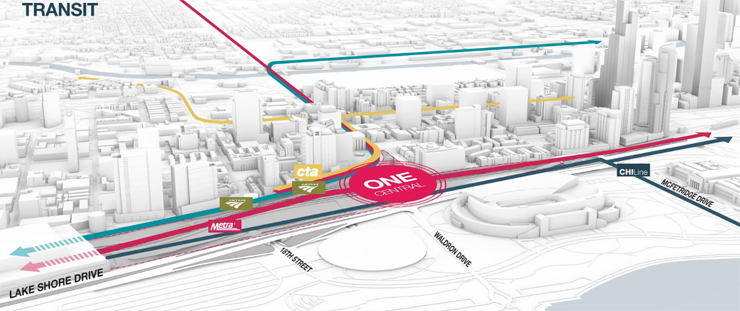CHICAGO — A major infrastructure program approved by the Illinois General Assembly calls for creation of a public-private partnership to help fund the construction of a $3.8 billion transit center linking Amtrak, Metra, the CTA, and the South Shore railroad in Chicago’s South Loop area.
The transit center would be part of a 34-acre residential and commercial development called One Central, which would be built on the air rights over the Metra tracks just west of Soldier Field. [See “Transit center proposed as key part of development over Metra tracks near Soldier Field,” Trains News Wire, March 14, 2019.]
Approved last weekend, the Public-Private Partnership for Civic and Transit Infrastructure Project Act calls for the developer, Wisconsin-based Landmark Development, to build and operate the transit center, which the state would help finance and eventually take over.
But transportation experts are questioning the necessity and the location of the proposed transit center. Joseph Schwieterman, a DePaul University professor and director of the Chaddick Institute for Metropolitan Development, told Trains News Wire he was skeptical of the “enormous undertaking” that would be involved to connect the CTA’s Orange Line, via a new spur, and Metra’s BNSF Line, via the St. Charles Air Line, to the site. Metra’s Electric District and the South Shore already use the tracks. Amtrak uses the Air Line.
The conceptual plan also calls for a proposed wheeled tram on a paved route, now used by buses, that runs alongside the Metra tracks. The tram, called the Chi-Line, would travel between McCormick Place and Chicago’s downtown.
Metra already uses Chicago Union Station, LaSalle Street Station, and the Ogilvie Transportation Center for the majority of its passengers.
The Chicago Metropolitan Agency for Planning has already advocated for such a transportation center in the West Loop. This center would reconfigure Union Station and ultimately lead to greatly improved connections between rapid transit, bus, commuter rail, and intercity rail services, according to CMAP’s On to 2050 master plan.
The $20 billion One Central development faces many hurdles. The developer has briefed the transit agencies and the city but has not received any official backing. Landmark has yet to submit any formal plans for the project. Neighborhood groups and area legislators have expressed concerns.
Indeed, Chicago Mayor Lori Lightfoot reportedly was upset with Landmark for first getting approval for the public-private partnership legislation “under cover of darkness.”
One Central harkens back to the name Central Station, the name for the neighborhood. That also refers to the site’s past as the location of Illinois Central’s Chicago station.
















Id rather see more superstations outside of downtown. For instance, A Cicero and Montrose CTA bus, Blue Line, Brown Line BRT, Mayfair METRA and Amtrak, eventual Midcity Transitway, all easily connected
I would exclude Amtrak trains, unless you can route all long-distance Amtrak trains into and out of this facility. Metra needs Union Station as their passenger volume is growing.
It’s getting ridiculous, trying to fund rail infrastructure with Monopoly Money. “Public-Private Partnership?” What in God’s name is that? You can either afford to fix the infrastructure or you can’t. Having someone else float the bonds and carry the costs doesn’t make it any cheaper to build nor does it increase the revenue. Cost is cost and revenue is revenue
I arrived yesterday at Dick (“Delta Dick”) Anderson’s gargantuan McNamara Terminal at Detroit Metropolitan Wayne County Airport. McNamara is the largest piece of infrastructure I’ve seen in my life. It obviously cost multiple billions of dollars and it’s obviously paid for because it’s economically viable – millions of passengers paying to fly (cheap), park (expensive) and purchase at the concessions (outrageous).
McNamara (which is the dominant but not the only terminal at DTW) seems a bit busier than Amtrak’s single-platform hut at Detroit New Center which sees six trains a day.
Rail infrastructure on the other hand can’t pay for itself no matter how the funny money is massaged.
The big news here in Metro Detroit is that the Republicans in Lansing want to fund road improvements by selling the Blue Water Bridge (which connects I-69 in Port Huron Michigan to Ontario 403 in Sarnia). Aside from the fact that a bridge is worthless on the market (it’s a liability, not an asset) what plans would there be to fund highways the second, third, fourth and fifth years ad infinitum.
Wake up, America. Infrastructure costs money. Add up the bill and pay it.
You want to know about infrastructure, visit the Motor City. The Edsel B. Ford Freeway which was the world’s best highway in 1959, is being patched together at 1959 traffic engineering standards, like fixing your roof one shingle at a time. The Walter P. Chrysler Freeway (late 1960’s) is in surprisingly good shape. Someone did something right. The Walter P. Reuther Freeway (I’m looking at it now outside the window of the hotel) was built to modern traffic engineering standards in the 1980’s but has been a constant maintenance headache, twenty miles of disintegrating concrete.
I mostly agree with David Peterson. And I tend to prioritize CREATE Grand Crossing connection myself. The CTA Orange Line spur and diverting Metra/BNSF trains to this location sound particularly suboptimal.
But I keep hearing advocates for the “reverse Grand Crossing” concept, that is moving all of the Amtraks now using the NS to access CUS onto the underutilized ex-IC at Grand Crossing and building a new connection from the St Charles Air Line down to the CUS southern approach.
Other than the potential delays at the diamonds with the Metra Rock Island district this idea is somewhat attractive in that it keeps Amtrak maximally segregated from freight, particularly those trains bound for the NS 63rd Street or 47th Street ramps or the trains that traverse the CJ connection to Ashland Avenue Yard and beyond (many also intermodal) or the NS-BNSF freight connection at Canal Street (mostly carload and bulk). I’ll admit my bias however is to streamline freight movements – particularly intermodal – through Chicago to better compete with trucks and not have to wait out passenger train interference when getting into or out of town.
But I have no idea how practical this idea is or how much more expensive it is compared to the “straight” Grand Crossing project that actually adds more Amtraks off the ex-IC to that aforementioned NS segment.
St Charles Air Line. Built 1856. Raised in 1895.
* * *
Per Wikipedia:
The Canadian National Railway’s employee timetable dated July 2011 states: “St. Charles Air Line is a connection between Metra 16th St. Interlocking and BNSF Union Ave. BNSF and UP jointly own the line between Union Ave. and a point 70 feet west of the Bascule Bridge over the South Branch of the Chicago River. CN owns the line from that point to 16th St. … Both tracks are designated Non-Main Track, CN Rule 520 applies, and is also designated East-West. The north track is Track 1, and the south track is Track 2. … The bridge is controlled by CSX Bridge Tender.”
* * *
OneCentral is just a developer trying to take advantage of air rights where property values have been rising quickly. Since the Donnelly plant closed several years ago, developers immediately took advantage of cheap land values so close to the Loop.
It makes absolutely no sense to route *any* Metra trains down the StCAL as the west lines are all served by Union Station or the OTC. Only an enhanced Metra Electric station that already serves McCormick Place is viable. Everything else is politics as usual.
Hey I don’t want to see the StCAL go anymore than anyone else, but CN just doesn’t need it anymore. As for the people complaining about the noise, they don’t blow horns here because its elevated. You would only hear the low rumble of the engine and maybe the clacks from the switch 4 blocks west. The CTA tandem buses make more noise during night owl services on Wabash Ave.
CN closest online customer is Marigold, way, way down at 87th Street. The non-electric part down there is used to store empty hoppers.
One Central is a ploy by the developer of the air rights over the Metra tracks to get government financing of the platform the developer needs to build buildings. It is an unwanted or needed transit center that is too far from where most commuters or Amtrak passengers destinations. The purpose of CREATE’s Grand Crossing Project is to divert freights and Amtrak trains off of the St. Charles Airline route which the residents of the Near South Loop area want removed.